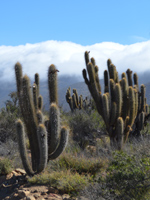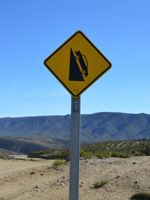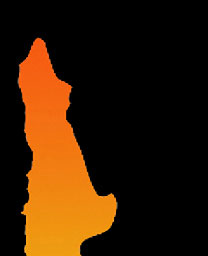

|
Forest in the Sky: Bosque Fray Jorge National ParkToday marked the beginning of a new phase of my journey in Chile, as I started off on a road trip north to the Atacama Desert. Finding my way out of the urban core of Valparaíso was a challenge, but the light Sunday morning traffic made it a little easier. Within a couple of hours of leaving my cabaña on Cerro Florida, I found myself in the wide open desert, surrounded by cacti, succulents, and lots of blooming spring wildflowers. For some parts of the route, the highway went alongside the ocean, revealing a spectacular rocky coast with broad sandy beaches and crashing waves. The highway is the Ruta 5, the Panamerican Highway, which runs north to south for 3,364 kilometers in Chile. It is a modern paved highway, with good signage and ample service stations along the way. It's not a freeway though; every 40-50 kilometers there is a toll booth. The toll amount varies each time, anywhere from 600 to 3400 pesos (about $1 to $5.60). After I got north of Los Vilos, I began to see small roadside stands with handwritten signs for Pan Amasado, a type of kneaded homemade bread, and Queso de Cabra (goat cheese). In some places, even the goat was for sale. I stopped at one of the stands and bought some pan amasado and a round of queso de cabra. I should have asked how much for the goat. I drove up the Ruta 5 for a few hours, arriving at the exit for the Parque Nacional Bosque Fray Jorge by mid-afternoon. From there, I didn't know what I had ahead of me. It started with a 28-kilometer rumble over a rough dirt road, traversing a beautiful desert countryside. The dirt roads in Chile are rutted by calaminas, a word that generally refers to the ubiquitous corrugated zinc roofs of buildings. In the context of roads however, it means the undulating bumps that form on dirt roads, creating a bone-shaking ride at even the slowest speeds. I love the creativity of Chilean Spanish. I passed through a couple of very small pueblitos, slowing down to veer around the dogs sleeping in the road and the donkeys and horses nearby. I reached the entrance to the national park and registered with the ranger. She told me about the natural features of the park and how to reach the trail that goes through the bosque, or forest. I had another 10 kilometers of rough road ahead of me, although I caught my first glimpse of what to expect. High up on the mountain in the distance, a thick bank of fog was rolling in from the ocean, and it was there that the forest could be found. The Parque Nacional Bosque Fray Jorge preserves a unique environment, one that has been declared a UNESCO Biosphere Reserve. It contains the northernmost Valdivian temperate rain forests, a type of forest that is normally found more than 1,200 kilometers to the south of here. The reason this forest is able to thrive here on the edge of the Atacama Desert is the camanchaca, the coastal fog that comes pouring over the mountains from the Pacific Ocean. The fog provides moisture and nutrition to subtropical vegetation in a small area of just four square kilometers that is a vestigial survival of the last glacial period. As I drove into the park, the camanchaca was increasing its force on the mountaintop. The road began to climb steeply and the hot desert air moderated with a distinct chill. Through the road signs along the steepest stretches, I learned a new meaning for the Spanish word enganchar, which literally means "to hook," but in this context means to put the car in first gear.
Finally reaching the top, I parked at the trailhead and immediately noticed that I needed to put on a long-sleeved shirt. The camanchaca was billowing in strongly now, rolling in over the mountaintops. I started off on the one-kilometer nature trail that loops through the forest, invigorated by the cool crisp air. The trail winds through an open desert environment at first, past flowering cacti and verdant succulents. Soon, the first few trees can be seen through the fog. The words of Pablo Neruda were in my mind as I entered the forest, a habitat I wasn't expecting to see in the Atacama Desert. "Anyone who hasn't been in the Chilean forest doesn't know this planet." The trail was beautiful and dramatic. The desert environment gradually gave way to dense forest, astonishing to see in an otherwise arid landscape. The fog was rapidly enveloping the hills in white mist, rolling across the gaps between rises. The poetry of the place was not lost on me as I listened to what Gabriela Mistral called "the silence of the fog." I hiked on through the forest, walking along a boardwalk placed to protect this fragile and isolated environment. Completing the loop and returning to the parking lot, I found I was the only remaining visitor in the late afternoon. I drove back down the treacherously steep road, this time in a state of total bliss, the kind of peace that comes from being in a natural wilderness. The bliss stayed with me the rest of the day as I drove to Ovalle, the small provincial capital of Limarí. On the way, I passed through La Plata, a small town where a religious procession filled the entire main street. The townspeople were all out, dressed in bright colors and carrying a large statue of the Virgin Mary through the streets of the town. I arrived in Ovalle and found a hotel room, looking out over the Plaza de Armas. From my window I could see the local families out strolling with their children, the young lovers, the skateboard boys, and the packs of wild dogs that seem to be everywhere. I sat and watched the show for a few hours, a nice way to end the first day of my road trip. |
||||||||||
|
|||||||||||
 |
|||||||||||
|
© 2015 Michael Hanrahan
|
|||||||||||


